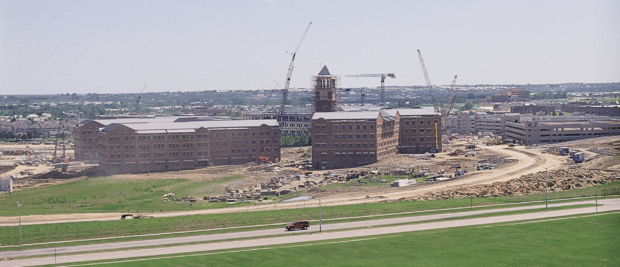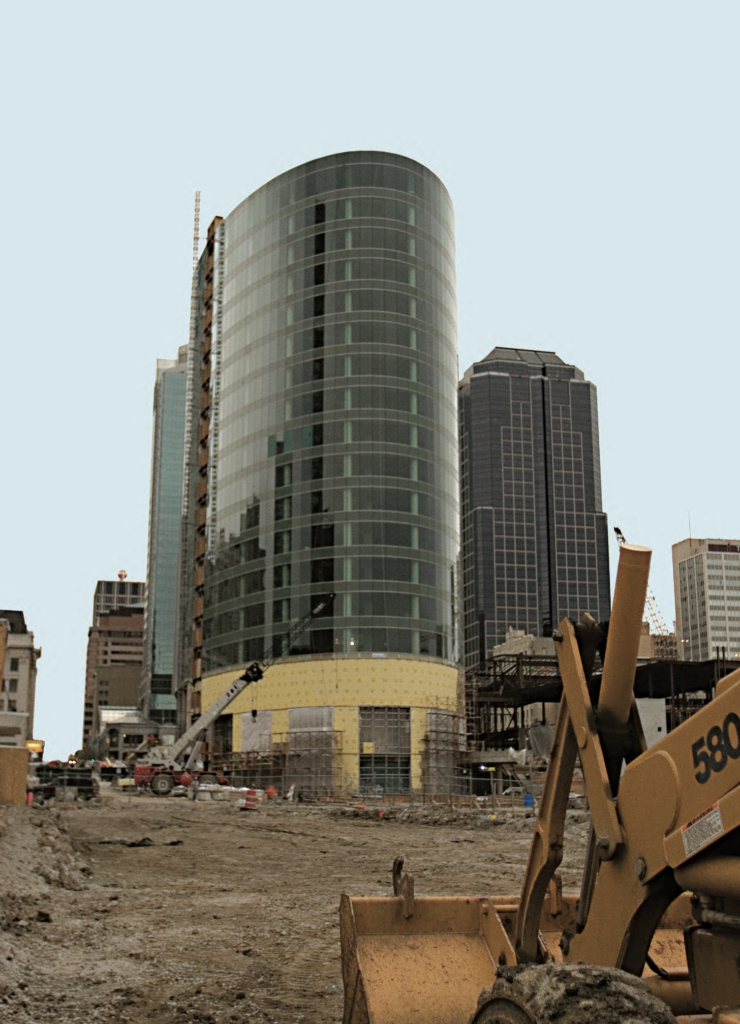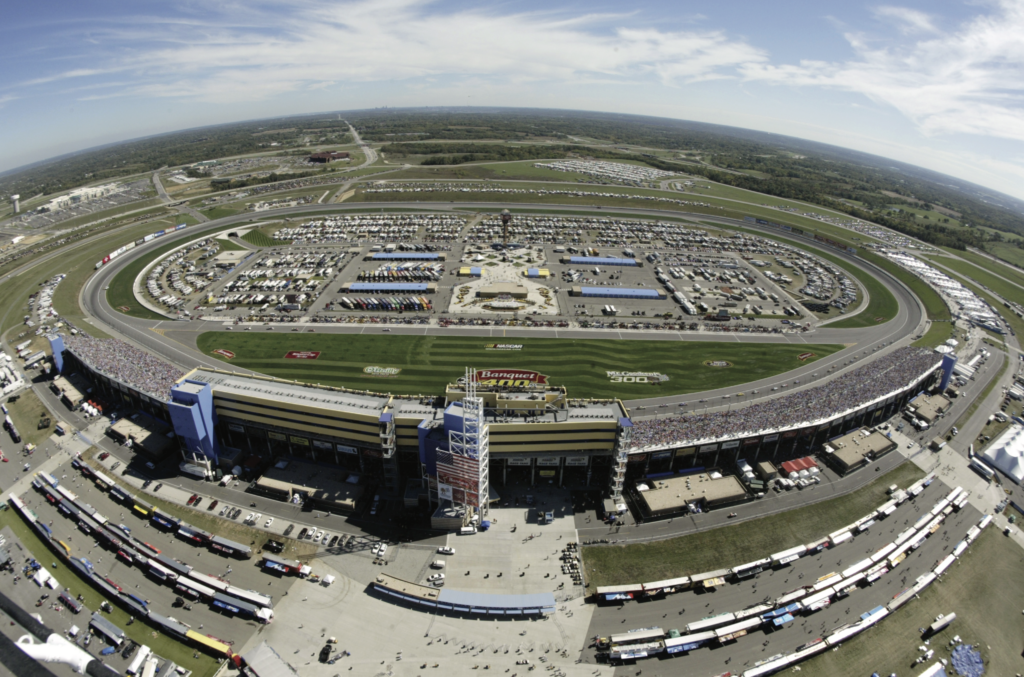HOME | ABOUT US | MEDIA KIT | CONTACT US | INQUIRE
HOME | ABOUT US | MEDIA KIT | CONTACT US | INQUIRE
As the Downtown revival picked up speed, the region boomed throughout the first years of a new millennium. Meanwhile, some very dark economic clouds were gathering.

As the 21st century arrived at center stage, the Kansas City area was poised for major developments on the business front. The decade of 2000-2009 would be marked by some high-profile multibillion-dollar busts, but also by some multi-billion-dollar breakout successes and market-transforming acquisitions. It was to be a decade of Downtown renewal, an amazing period of self-transformation for the metropolitan area. And it was to end with this region being sucked into the gaping maw of an economic downturn unlike anyone had witnessed going back to the end of the Great Depression a lifetime earlier.
Perhaps the most enduring of the changes sweeping this region from 2000 to 2009, was Kansas City positioning itself as a community that would not let its Downtown go quietly into that good night.
 That period began with civic commitments to restoring commercial and residential activity in the central business district, and none of those did more to light the spark than H&R Block’s 2003 commitment to build a new headquarters Downtown. From that would spring a transformed nightlife, but first, block after block of blighted property would have to be scraped clean to create the Power & Light District retail and entertainment zone. The Downtown revival topped things off by—partially—correcting a misjudgment made 30 years prior, unveiling what was first the Sprint Center and now the T-Mobile Center and pulling the convention-venue focus away from Kemper Arena in the West Bottoms.
That period began with civic commitments to restoring commercial and residential activity in the central business district, and none of those did more to light the spark than H&R Block’s 2003 commitment to build a new headquarters Downtown. From that would spring a transformed nightlife, but first, block after block of blighted property would have to be scraped clean to create the Power & Light District retail and entertainment zone. The Downtown revival topped things off by—partially—correcting a misjudgment made 30 years prior, unveiling what was first the Sprint Center and now the T-Mobile Center and pulling the convention-venue focus away from Kemper Arena in the West Bottoms.
As that was going on in the Central Business District, major lifestyle centers sprang up with Village West in Wyandotte County and Zona Rosa in the Northland, while the eastern side of the area saw a rebirth of commercial concentration along I-70 near I-435.
The decade wrapped up in the throes of an economic downturn unseen in depth since the Great Depression—a systemic failing of the banking system and federal policy that helped spawn an unstainable increase in housing prices. Construction and design companies, long a staple of the economic scene here, pulled back and regrouped for better days ahead.
An Age of Change
The decade got off to what many believed would be a promising start in 2000 when David Glass, a businessman who made his fortune at Walmart, purchased the Kansas City Royals from the estate of founder Ewing Kauffman in April 2000. Price: $96 million (keep that figure in mind when we catch up with the Royals ownership changes a generation later). Alas, over the next 10 seasons, the team would average roughly 94 losses a year, and just 67 wins, and last-place division finishes five times.
Among the biggest business deals of the year was, it turned out, a non-deal. Kansas City Power & Light Co. kicked off 2000 by calling off its $2.5 billion merger with Topeka’s Western Resources. It would take nearly a generation, with multiple fits and starts, before that union would be consummated, creating an electric-services behemoth with more than 1 million customers.
Evidence of the strength behind the region’s continuing push away from the urban core came at either end of the decade, and in each case, the fast-growing bedroom community of Lee’s Summit was remaking itself a suburban powerhouse. In 2000, it witnessed the opening of Summit Woods, bringing a higher level of retail to the area. That decade closed with another large-scale retail project opening its doors—Summit Fair, in 2009.
 On the other side of the metro area, momentum was also building in Wyandotte County. Three years after voters had agreed to unify the county government with that of Kansas City, Kan., additional evidence of economic revival was at hand. It arrived in June 2001 when the Kansas Speedway opened, the linchpin of new development in a plot of land dubbed the 400 acres.
On the other side of the metro area, momentum was also building in Wyandotte County. Three years after voters had agreed to unify the county government with that of Kansas City, Kan., additional evidence of economic revival was at hand. It arrived in June 2001 when the Kansas Speedway opened, the linchpin of new development in a plot of land dubbed the 400 acres.
That same month, one of the biggest office developments in Kansas City history also raised the curtain. Sprint campus in Overland Park, however, never reached its design goal of being home to 13,000 telecom workers. With that opening, it would be safe to declare that the former Brown Telephone Co. of Abilene, Kan., had reached its zenith.
The decade had begun—as it would end—with the U.S. telecom sector writhing amid change. In mid-2000, Sprint and Worldcom abandoned a proposed merger valued at $115 billion, surrendering to objections raised by the Justice Department over the impact on consumers. But just two years later, after successfully courting another suitor, Sprint was back in play. In January 2002, MCI Worldcom made a pitch that would have been the largest merger in U.S. history—$129 billion. Again, the Justice Department intervened. It didn’t help that by July, an accounting scandal rocking Worldcom would produce a bankruptcy filing. Needless to say, the marriage was called off in October 2002.
The decade wasn’t done with major news from Sprint. In 2004, it anno-unced plans to acquire Virginia-based Nextel Communications, rebranding as Sprint Nextel. But a corporate cultural clash and integration issues combined to drag down the value of the deal; Sprint ended up writing off $30.7 billion of the original $38.9 billion value. The resulting plunge in stock price eventually set the stage for acquisitions by Japan’s Softbank in 2012, and ultimately the 2021 purchase by T-Mobile.
Major changes were also afoot in the regional health-care space. The first of those came in 2001, when Health Midwest merged Trinity Lutheran Hospital, a Midtown fixture, with Baptist Medical Center in Brookside. The forces at work behind that move refused to recede following the merger; just two years later, HCA Healthcare—the largest health-care system in the U.S.—crashed the Kansas City party by acquiring the 12-hospital Health Midwest system for $1.13 billion and setting up shop with a new division, HCA Midwest Health. The impact of that sale, however, was not limited to the delivery of health-care services: As part of the deal, HCA also poured hundreds of millions into creating health-focused non-profit foundations, one on each side of the state line.
Among the biggest losses of that period was the 2002 bankruptcy filing of Farmland Industries. It was a stunning fall—and a fast one—for an agribusiness powerhouse that had been the largest ag cooperative in North America. The region also saw one of its biggest public companies bow out when Stilwell Financial was absorbed into Janus Capital Corp., a Denver company. That move cost 140 financial-services employees their jobs in Kansas City.
In more positive developments—or developments that suggested positive overtones—the Northland got in on the retail lifestyle boom sweeping the region, with the 2004 opening of Zona Rosa. The economic fundamentals of that project would be called into question in the years following, as would the decision by the city of Mission, in Johnson County, to secure a New York-based firm for redevelopment of the Mission Center Mall.
It was demolished in 2006 to clear the way for an ambitious plan by Gateway Developers/Cameron Group. Many hailed the firm’s vision with a $380 million mixed-use project brimming with 350 condominiums, half a million square feet of new retail, 180,000 square feet of office space, a tourist-attraction aquarium, 150-room hotel—even an extension campus for Johnson County Community College. A 2008 completion date was expected; a generation later, the crumbling site stands as a monument to failed dreams.
At about the same time, on the other side of the metro, the death spiral for covered malls was playing out at Blue Ridge Mall. The ownership made the call to tear it down in 2005, paving the way for Blue Ridge Crossing, a plan far more modest than the one offered in Mission, with a Walmart Super Center, a Lowe’s, and other retail offerings. Also, unlike the Mission vision, this one actually panned out by generating sales taxes and jobs.
Mid-decade also produced the fo-unding of a company that would produce global shock waves in the world of equities trading. In 2005, entrepreneur Dave Cummings who made it big with the founding of Tradebot Systems, rolled out BATS Global Markets. The high-speed, high-frequency trading platform would go on to become the region’s fastest-growing company, and, it turned out, one of the most attractive takeover targets before it sold for $3.6 billion, barely a decade after its founding.
Among the big exits of the decade was the sale of LabOne to Quest Diagnostics for a whopping $934 million. CEO Bill Grant had built LabOne into a major player in the $1 billion market, providing risk-assessment services for life insurance companies.
The back half of the decade brought more of the same: In Wyandotte County, growth near the Speedway extended to a new lifestyle shopping and entertainment district called Village West. It was a hugely transformative event, creating critical mass that would give incentive for other major retailers to settle on adjacent land.
In the health-care space, reverberations from HCA’s entry into the market continued with the 2006 opening of Centerpoint Medical Center in Independence, replacing the aging Medical Center of Independence and filling care gaps created by the earlier closing of Independence Regional Health Center.
Storm clouds were gathering on the nation’s economic horizon in 2007, but major additions to the city bolstered local optimism—at least for the time being. The Internal Revenue Service was wrapping up the completion of its new processing center, continuing the renaissance and adding hundreds of workers to the daily cacophony of Downtown life.
The decade that had begun with one failed merger involving KCP&L would see another successfully executed, as parent Great Plains Energy snapped up electric utility Aquila in a deal valued at $1.7 billion.
And by the fall, the latest filagree on Downtown redevelopment was etched with the opening of the Sprint Center. As openings go, it would be hard to top the headline act: country singer Garth Brooks, who responded to ticket demand by extending his appearance to cover nine sold-out shows. Downtown was indeed thriving again.
And as December wrapped up the fourth quarter of the year, the nation officially entered recession. Undeterred, a group of financial-services executives founded CrossFirst Bank, setting the stage for upheaval in regional banking—read: lending—patterns. It would quickly assume a growth arc that would earn it a spot among the regions Top 10 within just a few years.
A different stripe of optimism was playing out on the east side of the metro, with Kauffman Stadium launching a two-year, $250 million renovation. Only time would tell whether that was a wise move or a precursor to changes in the relationship between team and fans.
Also in 2008, the Federal Reserve Bank of Kansas City added its two cents to the Downtown renewal, opening a 600,000-square-foot tower on land formerly occupied by the old St. Mary’s Hospital.
That same year, Lenexa city leaders began assembling the acreage for a development almost unheard of in America: Creation of a new Downtown. Not a revival, but an outright relocation to open space with Lenexa City Center. It was an audacious move, and one that would play out—and pay off—over the next generation with its ability to attract office tenants, apartment residents, retail and entertainment venues.
The dark clouds gathering over America made things just a bit darker as the decade drew to a close. In May 2009, Trilogy Development Co.—the brainchild of advertising kingpin Bob Bernstein—filed for Chapter 11 bankruptcy with the failure of its $116 million West Edge project near the Country Club Plaza. It was a spectacular, almost unprecedented level of collapse with a building site that had to be razed to the ground again following construction/design failures.
Saying Goodbye
The decade witnessed the passing of some authentic giants of commerce and industry in the Kansas City region, along with some of the biggest names from its sports history.
Among the biggest of those: Jack Lockton, who founded a small insurance brokerage in his home nearly 40 years earlier, and Richard Bloch, one-half of the brotherly team that built H&R Block up from a modest accounting practice in 1955. Both died in 2004.
In 2002, the region lost Roger Cohen, co-founder of the Cohen-Esrey real-estate development empire, and Nathan Stark, who had served as Chairman and CEO of Crown Center Redevelopment Corp.
Also leaving us in 2004 were former Helzberg Diamonds CEO Jeff Comment, Koch Equipment CEO Lawrence Starr, and insurance executive Bill Wilkerson, who had led the family-owned Haas & Wilkerson insurance brokerage. A sports figure of note was Cotton Fitzsimmons, one-time coach of the Kansas City Kings.
In back-to-back years, the Kansas City Chiefs lost two pillars from its American Football League heyday: team founder Lamar Hunt, who also launched Hunt Enterprises and founded Major League Soccer, died in 2006. That was a year after the death of Hank Stram, architect of those 1960s Chiefs and winner of Super Bowl IV. Hunt’s death came just weeks after the region bade farewell to one of its Negro Leagues icons, Buck O’Neill.
In 2008, Indy 500 driver-turned-auto parts magnate Greg Weld died after a long illness, and though she had long since left this region, Margaret Truman Daniel had left a historical impact here as the daughter of former president and longtime Independence resident, Harry S Truman.
Another national figure with strong ties to the region was Walter Cronkite, the former CBS Evening News anchor who made the early-evening broadcast must-watch TV, albeit in an era where, with three networks, there weren’t many other options. He died in 2009, the same year as another national business figure, Koch Industries’ former president, Sterling Varner.
And as the decade wound down, we lost a giant of the Kansas City real estate scene, Allen Block.